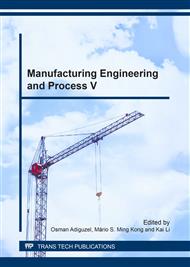[1]
F. Feucht, J. Ketelaer, A. Wolff, M. Mori, and M. Fujishima, Latest Machining Technologies of Hard-to-Cut Materials by Ultrasonic Machine Tool, 6th CIRP Int. Conf. High Perform. Cut., Vol. 14 (2014), pp.148-152.
DOI: 10.1016/j.procir.2014.03.040
Google Scholar
[2]
F. Klocke, S. L. Soo, B. Karpuschewski, J. a. Webster, D. Novovic, A. Elfizy, D. a. Axinte, and S. Tönissen, Abrasive Machining of Advanced Aerospace Alloys and Composites, CIRP Ann. - Manuf. Technol., Vol. 64, Issue 2 (2015), pp.581-604.
DOI: 10.1016/j.cirp.2015.05.004
Google Scholar
[3]
E. Kuljanic, M. Sortino, and G. Totis, Machinability of Difficult Machining Materials, Trends Dev. Mach. Assoc. Technol., (2010), pp.11-18.
Google Scholar
[4]
M. N. Kumar, S. K. Subbu, P. V. Krishna, and A. Venugopal, Vibration Assisted Conventional and Advanced Machining : A Review, Procedia Eng. Glob. Congr. Manuf. Manag. GCMM, Vol. 97 (2014), pp.1577-1586.
DOI: 10.1016/j.proeng.2014.12.441
Google Scholar
[5]
K. L. Kuo, Experimental Investigation of Brittle Material Milling Using Rotary Ultrasonic Machining, Proc. 35th MATADOR Conf., No. 2 (2007), pp.195-198.
DOI: 10.1007/978-1-84628-988-0_43
Google Scholar
[6]
K. Ding, Y. Fu, H. Su, X. Gong, and K. Wu, Wear of Diamond Grinding Wheel in Ultrasonic Vibration-Assisted Grinding of Silicon Carbide, Int. J. Adv. Manuf. Technol., Vol. 71, No. 9-12 (2014), p.1929-(1938).
DOI: 10.1007/s00170-014-5625-x
Google Scholar
[7]
B. Lauwers, F. Bleicher, and P. T. E. N. Haaf, Investigation of the Process-Material Interaction in Ultrasonic Assisted Grinding of ZrO2 based Ceramic Materials, Proc. 4th CIRP Int. Conf. High Perform. Cut., (2010).
Google Scholar
[8]
D. Lv, H. Wang, Y. Tang, Y. Huang, and Z. Li, Influences of Vibration on Surface Formation in Rotary Ultrasonic Machining of Glass BK7, Precis. Eng., Vol. 37, No. 4 (2013), pp.839-848.
DOI: 10.1016/j.precisioneng.2013.04.003
Google Scholar
[9]
O. Dambon, F. Klocke, M. Heselhaus, B. Bulla, A. Weber, R. Schug, and B. Bresseler, Vibration-Assisted Machining Research at Fraunhofer IPT – Diamond Turning and Precision Grinding, Am. Soc. Precis. Eng., (2007), pp.3-10.
Google Scholar
[10]
K. L. Kuo and C. C. Tsao, Rotary Ultrasonic-Assisted Milling of Brittle Materials, Trans. Nonferrous Met. Soc. China, English Ed., Vol. 22, No. Suppl. 3 (2012), pp.793-800.
DOI: 10.1016/s1003-6326(12)61806-8
Google Scholar
[11]
C. Zhang, J. Zhang, and P. Feng, Mathematical Model for Cutting Force in Rotary Ultrasonic Face Milling of Brittle Materials, Int. J. Adv. Manuf. Technol., Vol. 69, No. 1-4 (2013), pp.161-170.
DOI: 10.1007/s00170-013-5004-z
Google Scholar
[12]
Z. Jian-Hua, Z. Yan, T. Fu-Qiang, Z. Shuo, and G. Lan-Shen, Kinematics and Experimental Study on Ultrasonic Vibration-Assisted Micro End Grinding of Silica Glass, Int. J. Adv. Manuf. Technol., (2015).
DOI: 10.1007/s00170-014-6761-z
Google Scholar
[13]
B. Lauwers, D. Plakhotnik, M. Vanparys, and W. Liu, Tool Path Generation Functionality and Ultrasonic Assisted Machining of Ceramic Components using Multi-axis Machine Tools, Proc. MTTRF, (2008).
Google Scholar
[14]
X. Xiao, K. Zheng, and W. Liao, Theoretical Model for Cutting Force in Rotary Ultrasonic Milling of Dental Zirconia Ceramics, Int. J. Adv. Manuf. Technol., Vol. 75, No. 9-12 (2014), pp.1263-1277.
DOI: 10.1007/s00170-014-6216-6
Google Scholar
[15]
E. Uhlmann and C. Hübert, Ultrasonic Assisted Grinding of Advanced Ceramics, Am. Soc. Precis. Eng. -ASPE, (2007), pp.43-47.
Google Scholar
[16]
W. Cong, X. Zou, N. Wu, X. Wang, and Z. Pei, Rotary Ultrasonic Machining of Carbon Fiber Reinforced Plastic Composites: An Experimental Study on Cutting Temperature, J. Reinf. Plast. Compos., Vol. 31, No. 22 (2012), pp.1516-1525.
DOI: 10.1177/0731684412464913
Google Scholar
[17]
C. Zhang, S. Yuan, and J. Hu, Effects of Cutting Parameters on Ductile Material Removal Mode Percentage in Rotary Ultrasonic Face Machining, Proc. Inst. Mech. Eng. Part B J. Eng. Manuf., No. 37, (2014).
DOI: 10.1177/0954405414548497
Google Scholar
[18]
Y. Liu, H. Zhao, J. Jing, and S. Wei, Investigation on the Bonding Strength Patterns of Ultrasonic Vibration Tools and Influence on Working Performance during Rotary Ultrasonic Grinding, Int. J. Adv. Manuf. Technol., Vol. 65, No. 1-4 (2013).
DOI: 10.1007/s00170-012-4192-2
Google Scholar
[19]
E. Uhlmann and C. Sammler, Influence of Coolant Conditions in Ultrasonic Assisted Grinding of High Performance Ceramics, Prod. Eng., Vol. 4, No. 6 (2010), pp.581-587.
DOI: 10.1007/s11740-010-0265-y
Google Scholar
[20]
W. Cong, Q. Feng, Z. Pei, T. Deines, and C. Treadwell, Rotary Ultrasonic Machining of Carbon Fiber-Reinforced Plastic Composites: Using Cutting Fluid vs. Cold Air as Coolant, J. Compos. Mater., Vol. 46, No. 14 (2012), pp.1745-1753.
DOI: 10.1177/0021998311424625
Google Scholar
[21]
D. M. G. Na Qina, and Z. J. Peia, Ultrasonic Vibration Assisted Grinding of Titanium: Cutting Force Modeling with Design Of Experiments, Proc. ASME Int. Manuf. Sci. Eng. Conf., Vol. 2 (2009), pp.619-624.
Google Scholar
[22]
J. P. Davim, Design of Experiments in Production Engineering, Springer Int. Publ. Switz., ISBN 978-3-319-23838-8, (2016).
Google Scholar


